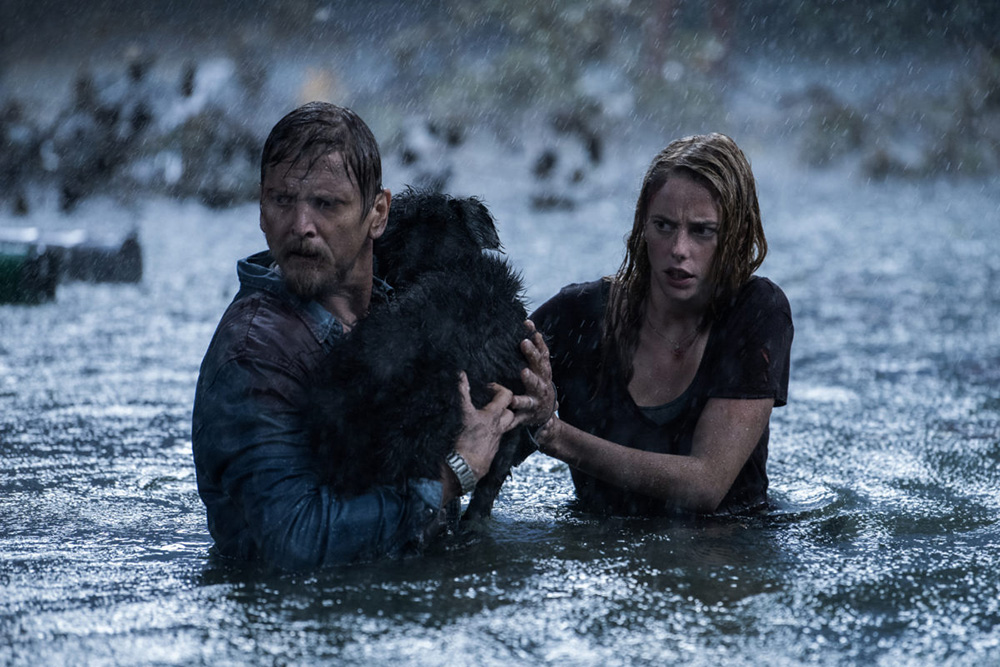A recent news story about the dangers of flushing meth down the toilet, based on a Tennessee police notice, featured the immortal line: “Ducks, geese and other fowl frequent our treatment ponds and we shudder to think what one all hyped up on meth would do... meth gators could become a thing.”
You had me at meth gators, but meth ducks are also pretty scary.
Every summer, along with barbecues and beach holidays, another annual ritual is enacted: the release of films dedicated to animals running amok. Historically, sharks have been the star of the show with Jaws, The Shallows, 47 Meters Down: Uncaged, The Meg and various Sharknados.
But almost every creature on the planet — snakes, goats, wolves, rabbits, fish, sheep, spiders, bears, slugs, frogs, monkeys, bees, bats, kitty cats — have had their chance to destroy humans on screen. And now it’s the gators’ turn.
The stars of director Alexandre Aja’s new film Crawl are a posse of scaly creatures ready to let loose in southern Florida. It’s a little like watching an especially gory spring break special — Gators Gone Wild, where lizard bros flash their naked teeth and wreck shit up. But before we get to the gnashing and the chomping and over-imbibing, we must trot through the initial setup, wherein we are introduced to the protagonist people (the ones you’re supposed to care about).
In Crawl, a blonde college athlete named Haley Keller (Kaya Scodelario) and her cranky old dad/swim coach (Barry Pepper) make up the human element. Trained since girlhood to be a rapacious competitor (“an apex predator,” in her terminology), Haley has lost her taste for winning. She’s fallen out with her father and is drifting down the drain of life.
Thankfully, a Category 5 hurricane is on its way, because there is nothing like massive destruction to allow humans to rediscover their family bonds.
As the storm ramps up, Haley ignores common sense and police directives and sets out to find her missing father, who has failed to return her phone calls. This being a horror film, no one ever does what they’re supposed to do, and this includes Daddy dearest, who has decided to do some plumbing repairs in the middle of a massive hurricane, as one does.
All of this is just a setup to get father and daughter pinned down by voracious gators so they have the opportunity to talk about where things went wrong in their relationship. If you think being forced to listen to that is more horrifying than being torn into colourful chunks by giant alligators, you’re not wrong. It’s genuine nightmare stuff. And as any longtime viewer of creature features knows full well, it’s always about the humans and their dumb problems.
In Jaws, it was the male fear of inadequacy, with a trio of men figuratively comparing penis size, all the while being stalked by the Moby Dick of sharks. In Hitchcock’s The Birds, the psychosexual tension between Melanie and her lover Mitch took furious flight.
In almost every film featuring animals attacking humans there’s an underlying issue, be it scientific hubris (Them) or environmental devastation (Prophecy).
In Crawl, it’s Florida.
The state has come to stand for the spiral of the human species into the madness of late-stage capitalism. And alligators are getting in on the act. Even the briefest perusal of Floridian news reveals a wide variety of gator thug activity, from eating corpses to home invasions to blocking traffic.
Is there nothing these naughty gators won’t do?
Crawl ups their rampaging crime spree to include attacking policemen and holding up convenience stores. Other Floridian clichés — storm surges, inadequate environmental protection and looting lowlifes attempting to steal an ATM are added for local colour. While the sad state of Florida forms the backdrop of the action, the foreground stuff is entertaining enough, and before the conclusion raises its lidless eyes above water there are some genuine pleasures to be had.
Director Aja knows what he’s doing, helped along with the support of another horror stalwart, producer Sam Raimi (Within the Woods, The Evil Dead). The central set piece of the film is the crawl space under the family house, wherein lurks a pair of hungry gators as well as a sizeable rat population, some spiders and a few other icky creatures. With the flood waters rising, and the cops proving to be no match for the party gators, it’s up to skinny little Haley and her swimming skills to outsmart the animals, survive the storm and single-handedly rescue her dear old almost-dead dad. Will she do it?
The film does its job capably and efficiently, mixing wet emotion with squishy viscera, and even chewier scene-stealing by a pack of hungry gators who are having a gay old time ripping folk into bite-size chunks and serving them up like sashimi.
As Haley and her father struggle for survival, it initially looks like a fair fight. Humans may be clever little creatures, with their cell phones and their outsized brains, but alligators have been around for millennia virtually unchanged. They were built tough, with plates of armoured skin, teeth like scimitars and the ability to hunt on both land and sea.
But of course, this being a movie made by people, the resolution is never much in question. Until alligators get producing credit and start making films of their own, humans will always be the heroes of the story.

Whether animals love us, hate us or want to eat us, it’s still all about us. As writer Jules Howard reflected in a recent essay in the Guardian, this species of projection is difficult to avoid.
As Howard writes about the death of his elderly cat, it isn’t so much the facts of its kitty existence as Howard’s feelings about it that most resonate.
“I often find myself wondering whether Dustin loved us. The shamefully needy part of me wants reassurance that we made his 11 years as pleasurable as possible. But can we ever really understand what pets feel for us? After a year of this topic swirling around in my head, I thought I would share where I’ve got to.”
It’s a thoughtful essay, exploring the different ways animals and humans interact, and the fundamental mystery of these relationships, from emotional support animals to emotionally unavailable house cats. But while love and other gentle feelings are the subject of Howard’s investigation, I would argue that hate is also an interesting area when it comes to our relations with animals. In this, horror movies offer a different kind of insight into human nature, namely what we fear.
In every film that pits people against the natural world the basic tropes of survival are present, but so is something else: retribution, revenge, a little payback.
The central conceit of many horror films is that we humans had it coming. We’ve been torturing the animal kingdom in the name of entertainment for centuries, whether it’s bear-baiting, bullfighting or chucking lemmings over cliffs for added drama in Disney movies.
Throw in factory farming, game hunting, overfishing and destruction of habitat, and we deserve a serious mauling, or at least a light evisceration. Horror movies are often the vehicle through which we sort through these feelings using an anthropomorphic lens, whether they feature a science project grizzly bear in Prophecy or the particularly vindictive shark in The Shallows (who seemed bound and determined to rip blithe Blake Lively limb from limb, even though there was a perfectly nice rotting whale carcass bobbing nearby).
Why do they hate us so much? Maybe because we’re the biggest killers on the planet, busily wiping out 80 per cent of other species for fun and profit. As Werner Herzog asserted in his documentary Grizzly Man, it was the vast indifference of nature that was truly horrifying. But things are getting a little more personal lately.
Animals are fighting back. Bear attacks surge every summer as people and animals compete for space. Even pretty little birdies are getting ugly. As evaporating ice floes force polar bears to look for other food sources, wasps, helped along by warmer weather, build nests the size of a car. I am waiting for the day when a killer whale has finally had enough and plucks a tourist off the rocks for lunch.
Nature out of whack has been the source material for a great many frightening films, and until now they’ve mostly been fictional. Reality is becoming increasingly like a scary movie, except that survival of the human species is no longer a foregone conclusion.
The great unspoken beast in Crawl is climate change. Rising sea levels, increasingly violent storms and starving animals — all precipitated by the greedy, terrible humans. In this new state of volatility, Florida may be on the frontlines, but every coastal community, Vancouver included, is seeing the destruction we have wrought coming to take revenge.
The meth gators are on their way. ![]()
Read more: Film
















Tyee Commenting Guidelines
Comments that violate guidelines risk being deleted, and violations may result in a temporary or permanent user ban. Maintain the spirit of good conversation to stay in the discussion.
*Please note The Tyee is not a forum for spreading misinformation about COVID-19, denying its existence or minimizing its risk to public health.
Do:
Do not: